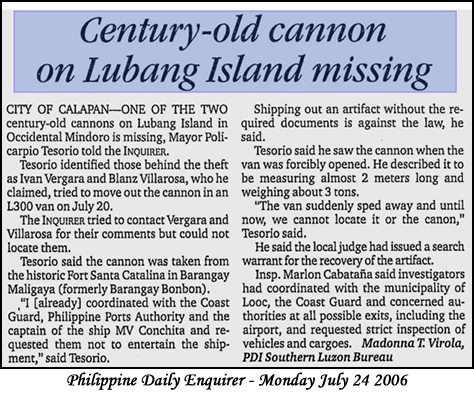
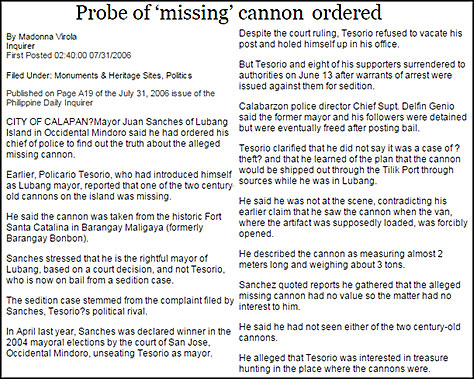
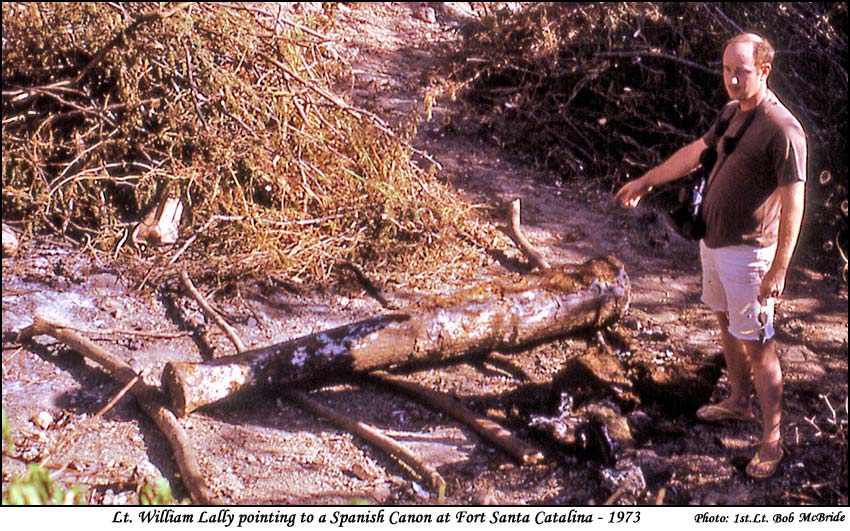
|
|
FORT SANTA CATALINA - LUBANG ISLAND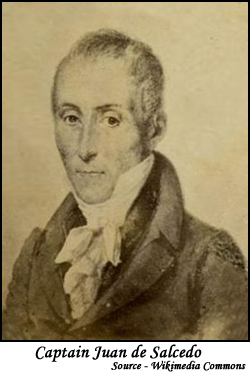
I became interested in Fort Santa Catalina when I read the first excerpt from the Philippines Daily Inquirer - pictured on the right. Then I found the continuation of what at first appeared an exciting adventure story and it is displayed below the first article. About a year ago Bob McBride sent me some photos taken in Lubang Island while he was working at Gozar Air Station. Amongst them was a picture of a Spanish canon found in 1973. A couple of days ago, (1 Aug. 2015), I decided to try and find more information about the Fort. It appears that the site has already been heavily worked over by people seeking pottery remains. Thus the only item left that is worth anything on the present site is probably the salvage value of the surrounding boundary fence. There is a local legend of a “golden bed” of the Spanish Conquistador, Juan de Salcedo. Juan died a poor man, at the age of 27 years. It is probable he was more interested during his adult years, in whose bed he slept, rather than what bed. Anyone interested in finding a golden bed might increase their chances by looking at the end of the nearest rainbow. "The fortification on Lubang Island is a rare example of a moated settlement and a defensive structure used by early Filipinos in the archipelago. The only other example of a moated site in the Philippines is the present site of Intramuros, found in the city of Manila. The walled city of Intramuros was also surrounded by a moat before it was rebuilt or restructured by the Spaniards. ... I was fascinated with the site" - Zandro Vasquez Villanueva. Below I have placed a photo of the Tam-Awan village in Baguio. There traditional artisans reconstructed houses and laid them out resembling the design of a traditional Cordillera Village. Possibly Fort Santa Catalina could be partially reconstructed and turned into a focal point for tourists. The location, in Maligaya, is less than 2 km. from the Municipality of Lubang Town Center. |


|
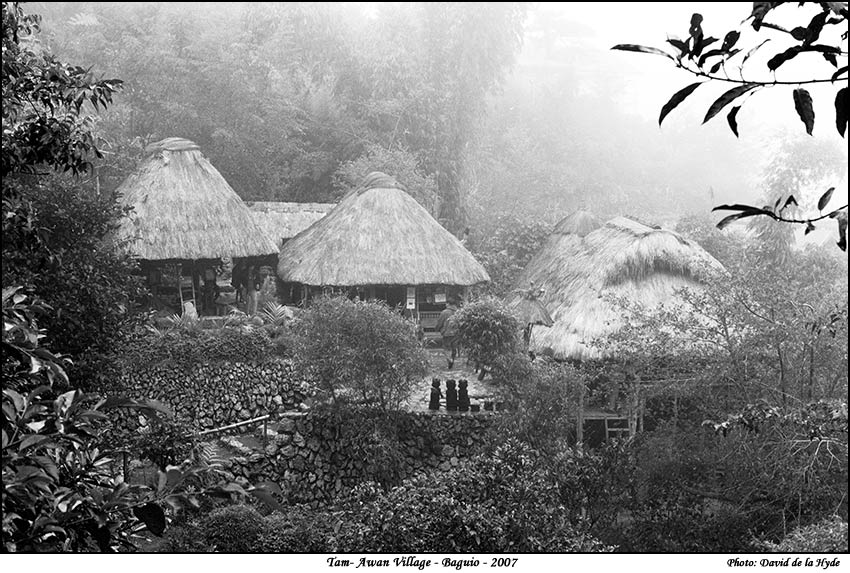
|
|
|
The following is an extract (written originally by Hernando Riquel, chief government notary) that covers the defeat, in May 1570, of Fort Santa Catalina by the Spanish, from Blair and Robertson "The Philippines, 1493-1898" Vol. 3, pp. 121-127. The first thing which I shall attempt to relate herein will be an expedition which was made by Captain Juan de Salzedo when he was governor in the island of Panai. As has been already related in other accounts, written in the year sixty-nine, the Portuguese raised the blockade established by them on the island of Cebu against the camp of his Majesty, because of certain difficulties which arose; and the governor determined to cross to the island of Panay with his captains in order to levy tribute upon the people of certain provinces. His nephew, recently made captain of the company which his brother Felipe de Sauzedo had brought to these islands, was sent with forty soldiers to certain islands. This captain embarked in fourteen or fifteen small native boats, and set out for an islet which is called Elem, ( islet off the southwest point of Mindoro which is now called Ilin) and when we had reached this island we did not find any resistance whatever, for all the natives came to us in peace. From there, led by a guide, he crossed to the island of Mindoro, and made an attack one night just about dawn upon a very rich native village called Mamburau, and plundered it. Many of the natives were captured, some of whom afterward bought their liberty, and others were allowed to go free. Thence he took a guide for a little islet, Loban (Lubang Island) by name, which is fifteen leagues (approx. 73 kilometers) farther. When the captain was departed, the natives, who had fled from the village, returned and saw the havoc and destruction caused by the Spaniards, and were unwilling to return to rebuild it; accordingly they themselves set fire to it, and totally destroyed it. The captain, having arrived at his destination at midnight, with all possible secrecy leaped ashore, and arranged his men and the Pintados Indians (indigenous warriors who painted their bodies with red clay) whom he had with him in ambuscade near the villages, in order to make the attack upon them at daybreak. However, the natives of this island having been informed of the hostile incursion of the Spaniards, withdrew with their children and wives and all their belongings that they could take with them, to three forts which they had constructed. Now since these were the first natives whom we found with forts and means of defense, I shall describe here the forts and weapons which they possessed. The two principal forts were square in form, with ten or twelve culverins on each side, some of them moderately large and others very small. Each fort had a wall two estados high (about 3.4 meters), and was surrounded by a ditch two and one-half brazas (about 2.6 meters) in depth, filled with water. The small weapons used by these natives are badly tempered iron lances, which become blunt upon striking a fairly good coat of mail, a kind of broad dagger, and arrows—which are weapons of little value. Other lances are also used which are made of fire-hardened palm-wood and are harder than the iron ones. There is an abundance of a certain very poisonous herb which they apply to their arrows. Such are the weapons which the natives of these islands possess and employ. Now as the captain approached the villages at daybreak, and found them empty, he proceeded through a grove to the place where the first fort was situated; (location of Fort Santa Catalina) and, having come in sight, negotiated with them, asking whether they desired to be friends of the Spaniards. The natives, confident of their strength, refused to listen, and began to discharge their culverins and a few arrows. The captain, seeing that they would not listen to reason, ordered them to be fired upon. The skirmish lasted in one place or the other about three hours, since the Spaniards could not assault or enter the fort because of the moat of water surrounding it. But, as fortune would have it, the natives had left on the other side, tied to the fort, a small boat capable of holding twenty men; and two of our soldiers threw themselves into the water and swam across, protected by our arquebusiers from the enemy, who tried to prevent them. This boat having been brought to the side where the Spaniards were, fifteen soldiers entered it and approached the rampart of the fort. |
As soon as these men began to mount the rampart, the Indians began to flee on the other side, by a passage-way which they had made for that very purpose. It is true that thirty or forty Moros fought and resisted the entrance of the Spaniards; but when they saw that half of our people were already on the wall, and the rest in the act of mounting, they all turned their backs and fled. A hundred or more of them were killed, while of our men five were wounded. In this way was the fort taken, together with fifty or sixty prisoners, ten or twelve culverins, and everything else in it. On the morning of the next day, which was the second of May, in the year one thousand five hundred and seventy, the captain set free one of the Moro prisoners, and sent him to the second fort, which was in the middle of the island very near the first one, and charged him to tell them that he summoned them to surrender peacefully. (possibly at the location of the future San Vicente Bastion, on the western point of the entrance to Port Tilik) The Moro having performed his mission, and delivered the message of the captain to those in the fort, they sent back the reply that they did not desire to be friends with the Spaniards but were eager to fight with them; and with this reply the Indian aforesaid returned to the captain. On the following day we went with some four hundred friendly Indians to the fort; and the captain, advancing within sight of it, addressed them, asking that they should be friends with the Spaniards and not try to fight with them, as that would result badly for them. They again declared that they did not desire this friendship, and began to fire their culverins and discharge arrows; and in return the soldiers discharged, on all sides, their arquebuses. But during the whole day we were not able to enter the fort, for we Spaniards were very few in number; and the heat was intense, and we had not eaten, although it was near night. The captain, seeing that he had not accomplished anything, decided to return to the boats which he had left behind, and on the next morning again to besiege the fort, and hem them in as closely as possible; and thus he did. Having come in this manner and having grounded his boats upon a beach close to the enemy, when these latter saw the determination of the Spaniards, and that they would not depart under any circumstances until they had conquered them, they therefore determined to make peace and become friends. To this end the leaders came out of the fort and made peace and friendship with the captain, becoming good friends, which they are up to the present time. They gave him a hundred taels, (tael, a Chinese unit of weight and currency. Most taels were equivalent to 1.3 ounces of silver or gold) which he divided among his soldiers. From there the captain went to a rock belonging to another small islet, (Cabra Island), very near to that of Loban, and lying in the sea at a very short distance from the said islet.The natives who lived in that island had retired to this rock to the number of about three hundred warriors. The captain, having arrived on the same day at about ten o'clock, went around the rock, and we captured a small boat containing thirty men. Many volleys from the arquebuses were fired at them during this day; and on the following morning the soldiers began to make ladders to scale the rock—whose occupants, when they saw the determination of the Spaniards, came to terms of peace and friendship, giving another hundred tael of gold, following the example of those of the other fort, who had been left good friends. The captain returned with all of us who were with him to the island of Panay, where the governor was with the master-of-camp, who had returned from another expedition made with his men to an island called Acuyo. Thereupon the question was discussed of sending men to explore the island of Luzon; and it was agreed that the master-of-camp and captain Juan de Sauzedo should set out upon this expedition with a hundred soldiers. References:
|
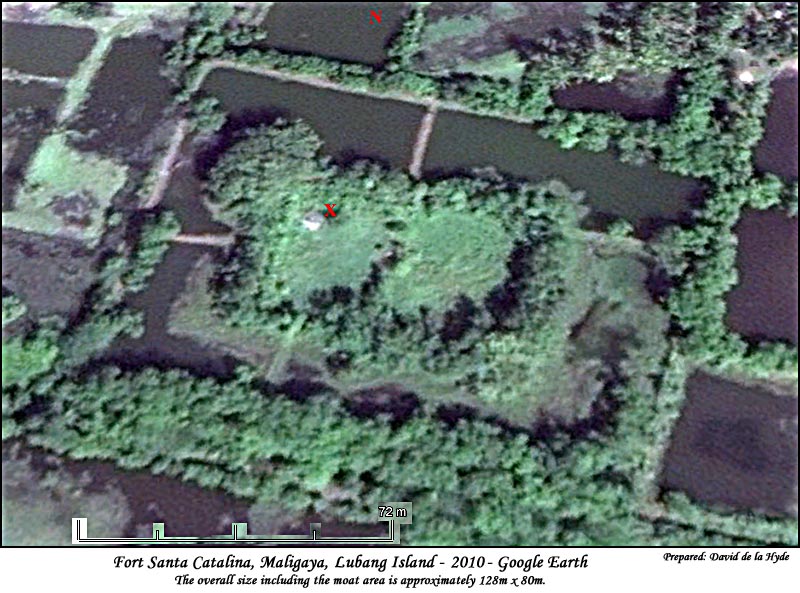
|
|
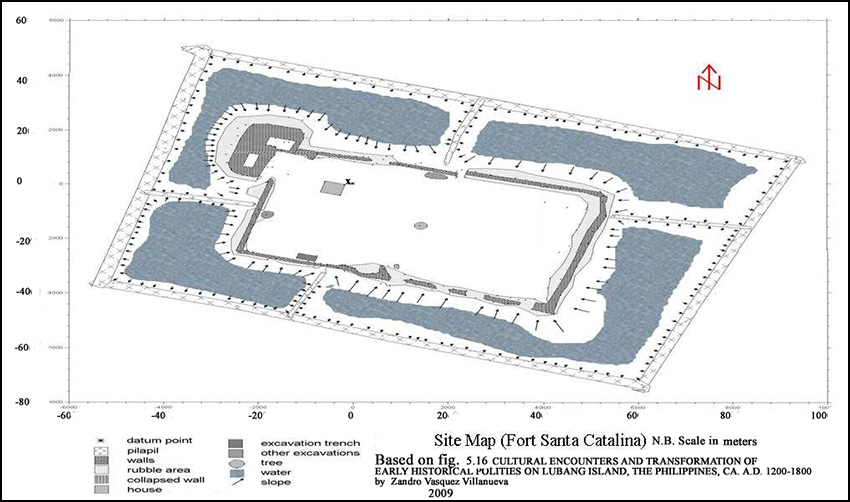
|
|